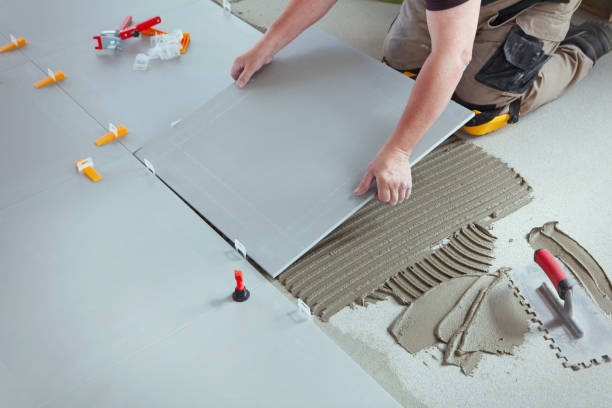The world of tile work design is constantly evolving, bringing fresh ideas and innovative styles to both floor and wall surfaces. Whether you’re remodeling a bathroom, kitchen, or an entire home, the latest trends in floor and wall tile design can help you create spaces that are not only functional but also visually stunning. Let’s explore some of the most exciting trends shaping tile design today.
1. Large Format Tiles
Large format tiles have gained immense popularity in recent years. These oversized tiles, often measuring 24×24 inches or more, create a sleek and seamless look with fewer grout lines. They make small spaces appear larger and lend a contemporary, minimalist aesthetic to any room. Large tiles are particularly effective for open-plan areas, bathrooms, and living rooms where you want to achieve a smooth, uninterrupted surface.
2. Textured Tiles
Textures are making their way onto tiles, adding depth and tactile appeal to walls and floors. From 3D geometric patterns to subtle embossed surfaces, textured tiles are a great way to add dimension to a room. They’re particularly popular in bathrooms, where textured wall tiles can create a luxurious, spa-like atmosphere. For floors, textured tiles also provide added slip resistance, making them both beautiful and practical.
3. Wood-Look Tiles
Wood-look tiles continue to be a major trend in flooring design. Made from durable porcelain or ceramic, these tiles mimic the appearance of natural wood grains, providing the warmth and elegance of wood with the low maintenance and water resistance of tile. Wood-look tiles are versatile and can be used in virtually any space, including kitchen and bathroom renovations areas, where real wood might not be practical.
4. Terrazzo Revival
Terrazzo, a composite material made of chips of marble, quartz, and other natural stones set in concrete, is experiencing a major revival in tile design. Modern terrazzo tiles are available in a variety of colors, from soft neutrals to bold, vibrant tones. They’re perfect for creating a retro or mid-century modern aesthetic, and their speckled appearance adds a playful and artistic touch to both floors and walls.
5. Bold Colors and Patterns
Gone are the days when tiles were only available in neutral shades. Today, bold colors and intricate patterns are trending in both floor and wall tiles. From vibrant blues and greens to rich terracotta and mustard, these bold shades add personality and energy to any space. Patterned tiles, such as Moroccan or geometric designs, are also making a statement, especially in accent walls, backsplashes, and entryways.
6. Natural Stone Tiles
Natural stone tiles, such as marble, granite, and slate, continue to be a timeless option for floors and walls. Each piece of stone is unique, offering variations in color and veining that create a one-of-a-kind look. While natural stone is often associated with luxury, it can also be used in more casual spaces to add a touch of elegance and sophistication.
7. Matte Finish Tiles
Matte-finish tiles are growing in popularity for their understated, soft appearance. Unlike glossy tiles, which reflect light, matte tiles offer a more muted and contemporary look. They’re perfect for modern and minimalist interiors, and their non-reflective surface makes them a practical choice for floors, where they are less likely to show smudges or water marks.
How Do I Measure for Premium Floor and Wall Tile Installation?
When planning a tile installation, accurate measurements are key to ensuring a smooth, professional finish. Whether you’re tackling a bathroom, kitchen, or any other area in your home, the right preparation can save you time, money, and material. Here’s a step-by-step guide on how to measure for premium floor and wall tile installation.

1. Understand the Area You’re Tiling
Before starting your measurements, determine the exact areas where you’ll be installing tiles. For walls, are you tiling from the floor to the ceiling, or just a portion? For floors, is the space rectangular, square, or irregularly shaped? Understanding the scope of the job helps plan the materials.
2. Gather the Necessary Tools
For accurate measurements, you’ll need:
- A measuring tape
- Calculator or smartphone
- Pencil and paper (or a measuring app)
- A notepad to record your measurements
3. Measure the Floor Area
Step-by-Step Guide:
Step 1: Measure the Length and Width
Start by measuring the length and width of the room or space. For rectangular or square areas, multiply the two dimensions to get the square footage.Example: If the room is 12 feet long and 10 feet wide, multiply:
12 ft x 10 ft = 120 square feetStep 2: For Irregular-Shaped Areas
If your space isn’t a perfect square or rectangle, divide it into smaller sections. Measure each section separately, calculate the square footage, and then add the total areas together.Step 3: Subtract the Non-Tiled Areas
If there are any areas you don’t plan to tile, such as built-in cabinets, subtract these measurements from the total square footage. Measure the length and width of these areas, multiply, and subtract.Example: If a cabinet space measures 4 feet by 2 feet:
4 ft x 2 ft = 8 square feet
Subtract this from your total:120 sq ft - 8 sq ft = 112 square feet
4. Measure for Wall Tile Installation
Step-by-Step Guide:
Step 1: Measure the Height and Width
For walls, measure both the height and width of the area to be tiled. Multiply these two measurements to get the square footage for each wall.Example: If the wall is 8 feet tall and 6 feet wide, multiply:
8 ft x 6 ft = 48 square feetStep 2: Consider Windows and Doors
If there are windows or doors, subtract their measurements from the total. Measure the height and width of each window or door, and subtract the square footage from your wall total.Step 3: Multiply for Multiple Walls
If you’re tiling multiple walls, measure each one separately and then add the square footage of all walls together.
5. Calculate the Total Square Footage
Once you’ve measured both floor and wall tiling works areas, add the totals together to determine how many square feet of tile you’ll need. If you’re only working on one surface (floor or walls), you’ll just use the total for that area.
6. Factor in Tile Cuts and Wastage
It’s crucial to account for tile cuts and wastage, which is common when working around edges, corners, and fixtures. A good rule of thumb is to add 10-15% to your total square footage to ensure you have enough tiles for mistakes and tricky areas.
Example Calculation:
If your total square footage is 150 square feet, and you want to add 10% for wastage:150 sq ft x 1.10 = 165 square feet
7. Plan for Grout Lines
Don’t forget to account for grout lines in your tile layout. Grout joints typically range from 1/16 inch to 3/8 inch, depending on the tile type. While these lines may seem small, they can slightly impact your overall tile count, especially over larger areas. Discuss grout spacing with your contractor for precise calculations.
8. Tile Format Considerations
The format or size of your tiles can affect how much waste you’ll produce. Larger tiles generally result in fewer grout lines and less cutting, while smaller tiles may require more precision and could lead to more waste. Be sure to choose a tile size that suits the layout and reduces waste.
What Should I Look for in Tiling Work Contractors in Dubai?
When embarking on a premium flooring solutions in Dubai, choosing the right contractor can make all the difference in terms of quality, durability, and aesthetics. Whether you’re renovating your home, office, or commercial space, finding a reliable and skilled tiling contractor is crucial. Here are the key factors you should consider when selecting a tiling work contractor in Dubai:

1. Experience and Expertise
One of the first things to look for in a tiling contractor is their experience and expertise. Experienced contractors have a deep understanding of different types of tiles, surfaces, and installation techniques. They can provide expert advice on tile selection, layout, and design, ensuring a polished and professional finish. It’s essential to choose a contractor with a proven track record in tiling projects similar to yours, whether it’s for kitchens, bathrooms, or outdoor areas.
Questions to ask:
- How many years have they been working in tiling?
- Do they specialize in specific types of tiling (e.g., ceramic, porcelain, marble)?
- Can they provide examples of previous projects?
2. Reputation and Reviews
A contractor’s reputation can tell you a lot about their work quality and professionalism. Look for contractors with positive reviews and testimonials from previous clients. Word-of-mouth recommendations from friends, family, or online communities in Dubai can also provide insight into the reliability and workmanship of potential contractors. Additionally, check online platforms such as Google Reviews or specialized local directories to see how they are rated.
Questions to ask:
- Can they provide references or client testimonials?
- Do they have any online reviews?
- Are they part of any professional associations or accredited by industry bodies?
3. Portfolio and Project Diversity
Review the contractor’s portfolio to gauge their versatility and attention to detail. A strong portfolio will show the contractor’s ability to handle a wide range of tiling jobs, from intricate mosaic patterns to large-scale commercial installations. Seeing their previous work gives you confidence in their ability to meet your project’s specific needs.
Things to consider:
- Do they have experience with different tile materials (e.g., ceramic, granite, limestone)?
- Have they worked on both residential and commercial projects?
4. Licensed and Insured
It is essential to hire a tiling contractor who is licensed and insured. Our floor tiling works contractors in Dubai, must comply with the legal standards set by local authorities, which ensures that they are qualified for the job. Insurance protects both you and the contractor in case of accidents or damages during the project. Always ask to see proof of licensing and insurance before signing any contract.
Questions to ask:
- Are they fully licensed to operate in Dubai?
- Do they have public liability and workers’ compensation insurance?
5. Quality of Materials and Equipment
The quality of materials used in tiling is crucial for durability and appearance. Reputable tiling contractors should have access to high-quality tiles, adhesives, and grout that are suitable for Dubai’s climate. They should also use modern equipment to ensure precise cuts, efficient installation, and a seamless finish.
Things to consider:
- Do they work with reputable tile suppliers?
- What type of grout and adhesive will they use?
- Do they use advanced tools and technology for accurate tile installation?
6. Clear Communication and Project Timeline
Effective communication is key to a successful tiling project. The contractor should be transparent about the scope of work, timeline, and costs. A professional contractor will provide you with a detailed written estimate, outlining the cost of materials, labor, and any additional expenses. They should also set clear expectations regarding project deadlines and update you regularly throughout the process.
Questions to ask:
- Can they provide a detailed project timeline?
- How will they communicate progress and any potential delays?
- Do they offer a written contract or quote?

Al Nadra offers an exquisite range of floor and wall tiles work in Dubai, our tiles are meticulously crafted to meet the highest standards of quality and design, ensuring that each piece not only enhances the aesthetic appeal of your environment but also provides durability and functionality. With a diverse selection of styles, colours, and textures, Al Nadra caters to various tastes and preferences, making it the ideal choice for homeowners, architects, and designers seeking to create stunning spaces.

